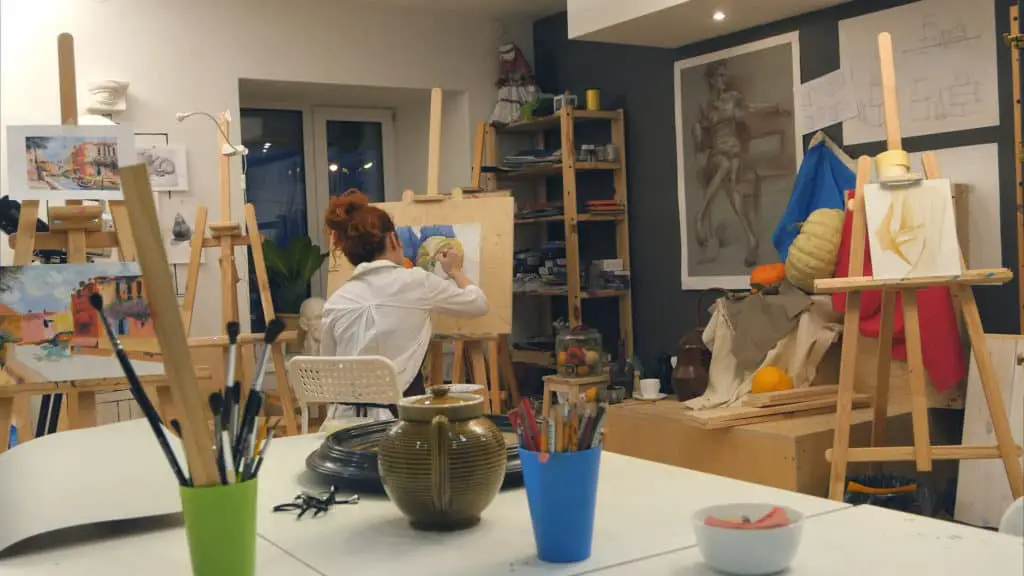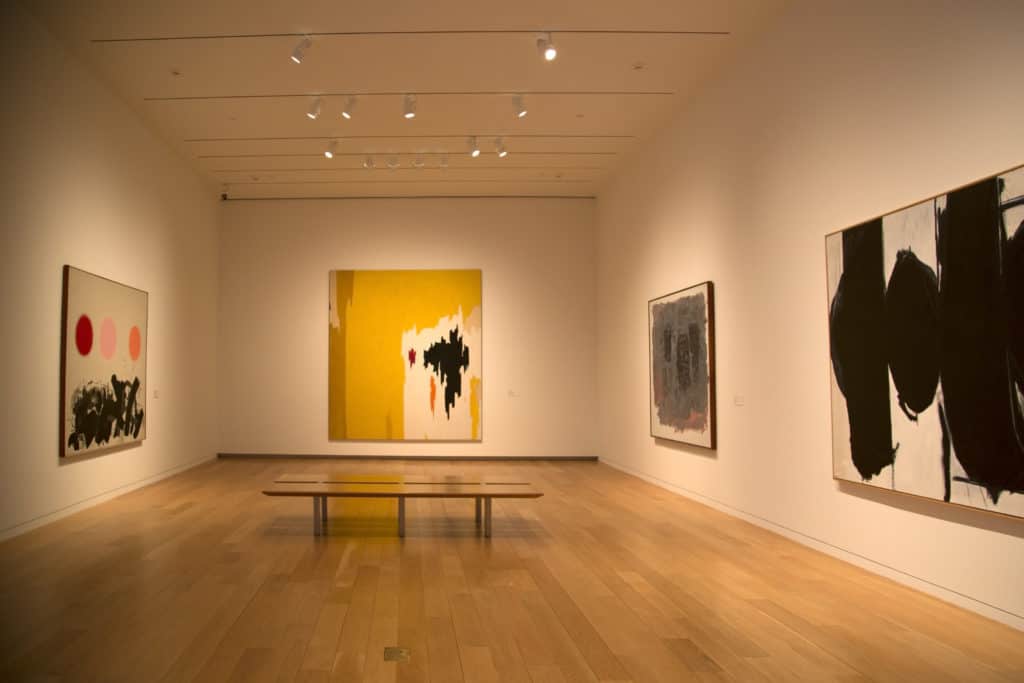In 2017, a Leonardo da Vinci sold for over $450 million at Christie's, while an Ana Moraes is currently priced at $180 on RevArt. New art collectors will face an extensive range of prices when beginning to buy artworks. In general, an artist's career stage will hint at how much an art piece will cost.
The cost of a piece of art for emerging artists ranges between $200 and $800. Works from mid-career artists are priced around $1000 to $5000. Work from established and deceased artisans cost over $10,000. Materials, labor, antiquity, and notoriety all factor into the value of the artwork.
Of course, an artist's body of work and experience is not the only way to segment art pricing. But for us beginners, it's a good first guideline. Here's a breakdown of what you can expect from each career stage and the associated costs of a piece of art within each category.

Emerging Artists
An emerging artist is early in their journey and is trying to kick-start their art career, typically selling their art pieces for the lowest prices. This is not due to a lack of quality or talent. Many emerging artists are just as talented as Van Gogh yet do not sell at Van Gogh rates. Van Gogh's pieces sell for millions because of his pieces' antiquity and notoriety.
There are three main categories of emerging artists selling into the art market to gain professional experience:
- Hobbyists
- Students
- Professionals
Hobbyists
Hobbyists can be young or old and may have been creating art for months or decades. Hobbyists see art creation as more of a passion and less as a source of income. Hobbyists typically like little to no formal training and have figured out techniques for themselves. Their main goal is to create, not necessarily to sell.
But, more and more hobbyists have been able to sell their work, thanks to the internet. With platforms like Etsy, Redbubble, Pinterest, and eBay, hobbyists can easily freelance their work online without having to go through the process of being accepted into an art gallery. Because hobbyists are typically lesser-known and do not have formal schooling, their art will cost less.
Hobbyists typically cannot sell their work for more than $200. This number, of course, depends on:
- The quality of the piece
- The piece's size
- The cost of the materials used
- The amount of time spent on the artwork.
But, because hobbyists typically have not yet made a name for themselves and do not have formal training, it's unlikely they can sell their work above this threshold.
Hobbyists typically never break above this threshold if they do not go on to receive schooling. But, this is not always the case. Sometimes, after hobbyists pass away, the prices of their artwork skyrocket. The art market is unpredictable and finicky, which can work in favor of some living artists, but usually works in favor of artists that are already long gone.
Students
Student artists' art pieces typically sell for a bit more than that of hobbyists. Because they receive formal training, collectors can assume that their skills and understanding of theory will produce higher quality, more profound art pieces.
Students have also begun to create names for themselves. They typically have portfolios of critiqued works, an asset that increases their value as artists. Student artists also have made professional connections within the art industry, a key step that many hobbyists do not have. Students will receive more endorsements/recommendations by making connections in school, especially from art class instructors.
Student artwork can typically sell from $300 to $500, again depending on time spent, quality, and size of the piece. The difference between student artists and hobbyists is that student artists usually refuse to price artwork below a certain threshold. Part of the appeal of an art piece is the artist's confidence that it is worth a certain amount of money.
Many hobbyists do not actually know what their work is worth and under-price their work to appeal to their customers. Students are taught that their art is valuable (due to their schooling and dedication to a medium) and should not sell themselves short. Thus, their artwork will be a bit more expensive and will probably be of better quality.
Heads up:
Students can also be one of the main types of art snobs. Their new-found training coupled with inexperience can result in this trait. Pretension frequently becomes less pronounced as the move into a professional career stage.

Professional
Professional artists have usually gone to art school, have already established their names in the art industry, or both. One is considered a professional if he or she has an exceptional understanding of art theories and techniques. Professionals are seasoned within the art industry, have sold many pieces, and have established a framework of connections.
Professional artists are the main kind of artists found in art galleries and art shows. Art galleries want to produce as much revenue as possible and often believe that professional credentials will skyrocket artwork prices. This is usually, but not always, the case. Professional artwork is typically priced higher than student or hobbyist work.
The work of a professional artist is typically priced around $400 to $800. This is significantly higher than that of a hobbyist but still does not compare to an established artist's rates. Professional artists are known more for their art style and less for their names. They are judged more for their pieces' quality than for the reputations they have created for themselves.
Name and reputation do not often come into play until an artist is very well established or has deceased. While a professional artist may have the schooling, critique, and practice, he does not have the asset of a name to support him. For the prices of art to increase, a professional artist must have success selling experimental/unique work--to create a reputation for herself.
By the way:
You might be wondering if artists are considered rich? We dug into the salaries of many types of professional artists to determine if artists are rich.
Mid-Career Artists
Mid-career artists are professionals who have likely sold hundreds, if not thousands of pieces. They have many connections within the industry and typically have artwork being sold in multiple upscale galleries. They are likely no longer local artists and have branched out to sell their work nationally or internationally.
What makes mid-career artists stand out from emerging professionals is that they have:
- Been featured in publications/museums
- Received national/international recognition for public presentations
Mid-career artists' work is typically priced between $1000 to $5000. National recognition is what sets mid-career artists apart from early professionals and emerging artists. Their fame is culminating, but they still have not fully established themselves as art icons. Their styles are likely very unique and could not be easily replicated.

Established Artists
The status of an established artist is extremely difficult to achieve. It typically requires years, if not decades, of work and dedication to a medium. Established artists have achieved icon status, and they have affected art trends in one way or another. They are nationally and internationally recognized and are featured in museums, elite galleries, publications, etc.
The work of an established artist can be worth over $10,000 and oftentimes much more. The price of an established artist's work is high because of the artist's name and fame. By investing in a piece from an established artist, you are investing in the artist's name. Art prices work similarly to the stock market; they go up when there is a great buzz around an artist's name.
Most artists will never reach this level during their lifetime. Frequently, artists will pass away as mid-career-artists and posthumously step into the established artist realm.
Posthumous Art Prices
Just because a well-known artist dies does not mean that his or her artwork will increase in value exponentially. Several factors, such as an artist's notoriety, impact on the arts and culture, and antiquity of the piece, determine an artwork's worth.
Masterworks are the ones audiences visit and photograph in museums and galleries, but they may only attain this notoriety decades or even centuries after an artist's passing.
Posthumous art can cost, at a minimum, $10,000 when there's a previously-sold body of work. Sometimes posthumous art pieces are sold for hundreds of thousands or even millions of dollars. Investing in artworks like these is a form of gambling for those who can afford it. The price may and probably will continue to increase over time. Many see investing in this kind of artwork as similar to buying property or real estate.
The price of a posthumous art piece can be unpredictable, especially while the artist is still alive. If an artist is already established and internationally known, there is a good chance that the price of this artist's work will inflate after his or her death. But there is no telling how soon this inflation will occur, if at all. Investing in posthumous art pieces can be a game of luck. It's important to find attachment to the work itself and not its value.
Unconventional Price Range
Remember that you don't have to be purchasing an expensive painting or custom mural to find fine art at your price range. There are so many varieties of artists from varying levels of experience.
I tracked down and hired a long-lost friend to take some symbols and produce concept art for my tattoo. I even convinced Mike to have our wedding rings inked at the same time.


Our city has a ton of graffiti and street art, where commissioned (and noncommissioned :-) artists use the cityscape as their canvas producing excellent original art. I often find myself in deep research on Pinterest and Instagram to find the artists' profiles. I'll reach out to them to see where they're at in pricing art that I like.
Look for an illustrator drawing caricature pieces at fairs or carnivals. They frequently sell celebrity works, or you can be commissioned for unusual pieces.
Art cost is a factor for most collectors, but it's no the only component when considering what to buy. Find what makes you appreciate and emotionally connect with the art you own.